VY Canis Majoris (VY CMa) is a red supergiant or red hypergiant star located at an approximate distance of 3,820 light-years from Earth in the constellation Canis Major. It is one of the largest stars known, with an estimated radius at least 1,420 times that of the Sun. The hypergiant is a pulsating variable star. With an apparent magnitude that varies from 6.5 to 9.6, it is just below unaided eye visibility at its brightest.
VY Canis Majoris is one of the most massive and luminous red supergiants known in the Milky Way. It is a single star, without any known companions. The star is surrounded by a complex circumstellar envelope (CSE) formed of material expelled from the star’s surface.
Star type
VY Canis Majoris is an oxygen-rich red hypergiant or supergiant star with the stellar classification M2.5 – M5e Ia. It has a mass about 17 times that of the Sun and a radius 1,420 times solar. Some estimates of the star’s radius go as high as 2,069 solar radii.
With a surface temperature of about 3,490 K, the supergiant is about 270,000 times more luminous than the Sun. Some astronomers estimate the star’s luminosity to be considerably lower at about 178,000 solar luminosities.
VY CMa is a very fast spinner. It has a projected rotational velocity of 300 km/s. The star’s estimated age is only 8.2 million years.
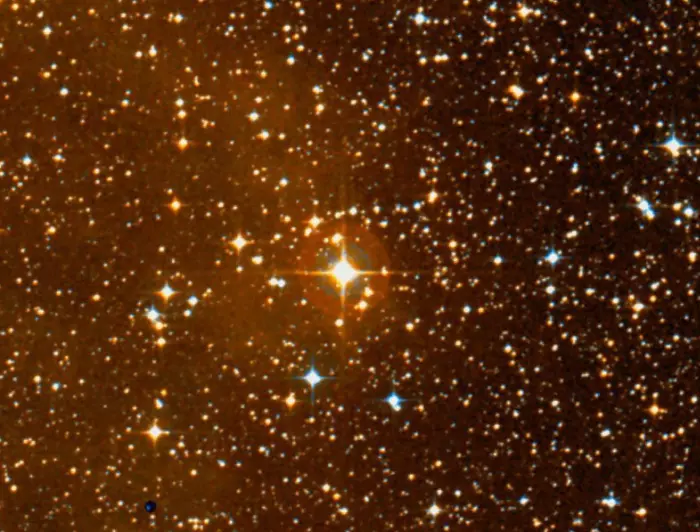
VY Canis Majoris, image: Wikisky
VY Canis Majoris has complex spectral features, ones that the current stellar classification system cannot fully describe. While the star is usually classified as a high-luminosity M-type star, the hydrogen lines in its spectrum have P Cygni profiles, which normally indicate a luminous blue variable star like P Cygni, Eta Carinae, S Doradus, Wray 17-96, the Pistol Star, or the Peony Star.
The P Cygni profile is characterized by the presence of both absorption and emission in the profile of the same spectral line, which indicates the presence of a gaseous envelope speeding away from the star.
The spectrum of VY CMa is dominated by titanium(II) oxide (TiO) bands. Based on the strengths of these bands, the star is given the classification M5.
With an effective temperature below 4,000 K, VY Canis Majoris occupies the upper right corner of the Hertzsprung-Russell diagram. The HR diagram is a scatter plot of stars at different evolutionary stages that shows the relationship between their effective temperatures and spectral types on the one hand and their luminosities (absolute magnitudes) on the other. However, since the exact temperature and luminosity of VY CMa depend on the star’s distance, they remain uncertain, as do the star’s other properties.
While VY CMa is usually given the luminosity class of a supergiant (I) or hypergiant (Ia+), it is sometimes classed as a bright giant (II) based on different spectral features.
VY Canis Majoris is classified as a variable star. The hypergiant shines at magnitude 6.5 at maximum brightness and at magnitude 9.6 at minimum. Its brightness varies due to pulsations. The estimated period of the pulsations is 956 days. Other periods of 1,600 and 2,200 have also been reported.
The General Catalogue of Variable Stars (GCVS) lists VY Canis Majoris as a semiregular variable star (type SRc), while the American Association of Variable Star Observers (AAVSO) classifies it as a slow irregular variable (type Lc).
Semiregular variables of the type SRc are typically supergiants of late spectral classes. They show periodicity in their brightness variations, sometimes interrupted by irregularities. The class includes many well-known red supergiants, such as Betelgeuse, VV Cephei, Mu Cephei, VX Sagittarii, AH Scorpii, NML Cygni, and Rasalgethi.
Slow irregular variables do not exhibit periodicity. Well-known examples of the type-Lc stars include Enif in the constellation Pegasus, Antares in Scorpius, Suhail in Vela, Unurgunite in Canis Major, Pi Aurigae in Auriga, and TZ Cassiopeiae in Cassiopeia.

The star VY Canis Majoris is a red hypergiant, one of the largest known stars in the Milky Way. In its current state, the star would encompass the orbit of Jupiter, having expanded tremendously as it enters the final stages of its life. New observations of the star using the SPHERE instrument on the VLT have clearly revealed how the brilliant light of VY Canis Majoris lights up the clouds of material surrounding it and have allowed the properties of the component dust grains to be determined better than ever before. In this very close-up view from SPHERE the star itself is hidden behind an obscuring disc. The crosses are artefacts due to features in the instrument. Image credit: ESO (CC BY 4.0)
Nebula
VY Canis Majoris is surrounded by an asymmetric red reflection nebula formed of material lost from the star. The nebula has an estimated mass of 0.2 – 0.4 solar masses and a temperature of 800 K. It shows a complex distribution of filamentary arcs and knots and obscures the central star. The arcs and filaments were produced in multiple past eruptions.
The nebula’s inner shell measures 0.12 arcseconds across, corresponding to a physical size of 140 astronomical units at a distance of about 1,200 parsecs. The outer shell is 10 arcseconds across, corresponding to a size of 12,000 AU or 0.19 light-years (Earth-Sun distances). The material in the outer shell was expelled about 1,000 years ago, while that near the star could have been expelled only 50 years ago.
A team of researchers led by Roberta Humphreys of the University of Minnesota measured the motions of the material expelled from the star and mapped the distribution of polarized dust. They presented the results of their study at a meeting of the American Astronomical Society in January 2007.
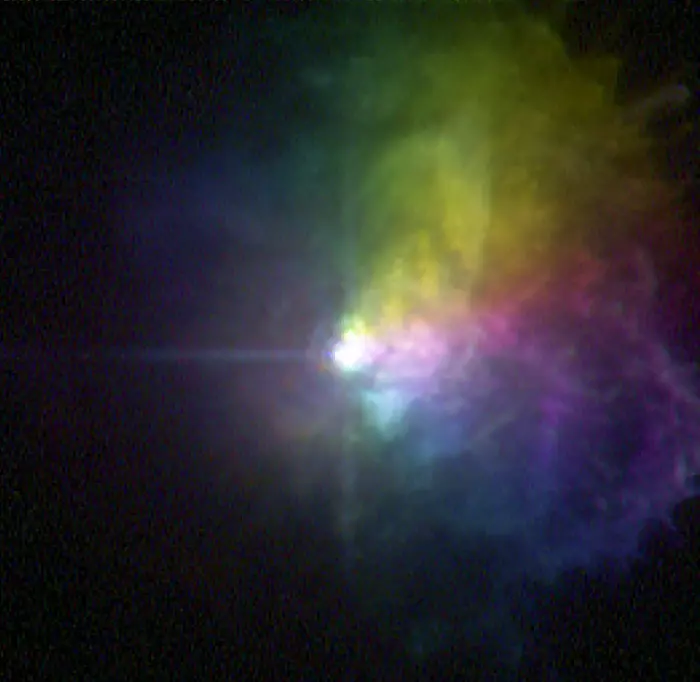
VY Canis Majoris polarized light. Image credit: NASA, ESA, and R. Humphreys (University of Minnesota)
The three-dimensional reconstruction of the envelope of VY Canis Majoris, created based on observations with Hubble and the W.M. Keck Observatory, Kameula, Hawaii, revealed that the gaseous outflow from the red supergiant star was much more complex than previously believed. The ejections of material have produced knots and arcs that move at different speeds and in different directions. During outbursts, VY CMa loses about 10 times more mass than it normally does.
The arcs and knots are associated with massive outflows of gas that was likely expelled from large star spots or convection cells on the star’s surface.
The random orientation of the jets indicates that they are the result of outbursts in active parts of the star’s photosphere. Since the jets move away from the star at different speeds, they likely originate from multiple outburst episodes in different regions of the star. The jets are similar to coronal mass ejections but much greater.
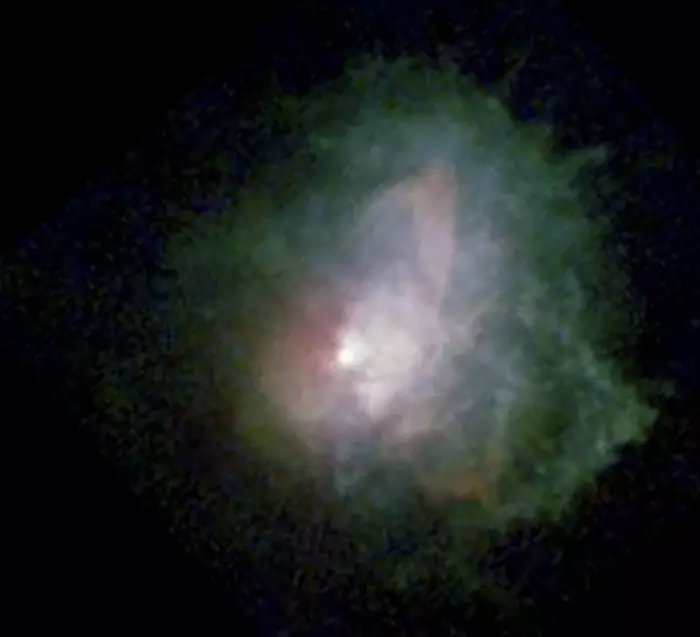
Massive Star VY Canis Majoris – Visible Light. Image credit: NASA, ESA, and N. Smith (University of Arizona)
Size
The estimated radius of VY Canis Majoris is 1,420 ± 120 solar radii. An object travelling at the speed of light would take 6 hours to travel around VY CMa. The same object would need only 14.5 seconds to make a circle around the Sun.
Estimating the radius of a pulsating red supergiant or hypergiant is made complicated by the fact that the star’s radius changes with the pulsations. The circumstellar envelope of ejected material makes it harder to obtain accurate measurements of the star.
The radius of VY CMa is considered to be the size of the star’s optical photosphere. The size of the star’s radio photosphere is twice the size of the optical photosphere. Even though VY CMa is large and massive, it has an average density of only 5.33 – 8,38 mg/m3, which is more than 100,000 times less dense than Earth’s atmosphere at sea level.
The radius of 1,420 R☉ was derived based on near-infrared observations of the star using the spectro-interferometric AMBER instrument on the Very Large Telescope (VLT). The researchers directly measured the star’s angular diameter at 11.3 ± 0.3 mas. The size of VY CMa corresponded to its Rosseland radius where optical depth falls below 2⁄3. The same team derived an initial mass of 25 solar masses for a rotating star or 32 solar masses for a non-rotating star.
The diameter of VY CMa is close to the Hayashi limit. This is the theoretical constraint on the maximum radius for a given mass of a star that is within hydrostatic equilibrium, where the inward pull of gravity is equivalent to the outward pressure of gas.
Estimates of the radius of VY CMa have varied greatly in recent decades. A study published in 2006 gave a value of about 600 solar radii with a temperature of 3,650 K and a luminosity 60,000 times that of the Sun, suggesting that both VY CMa and fellow supergiant or hypergiant NML Cygni were normal red supergiants experiencing a highly unstable time.
However, most earlier estimates were much higher, some even exceeding 3,000 solar radii. Studies published in 2006 and 2007 derived sizes of 1,800 – 2,100 solar radii based on an estimated temperature of 3,450 – 3,535 K and a luminosity of 430,000 L☉.
A 2014 study used a radius of 2,069 solar radii and a luminosity 237,000 times that of the Sun with a temperature of 2,800 K in an analysis of the star’s far-infrared and submillimetre molecular emission-line spectrum.
VY Canis Majoris was once the largest star known. It is still believed to be larger than many other behemoths, including Betelgeuse (764 – 1,021 R☉), Antares (680 R☉), Mu Cephei (972 R☉), and Mira (332 – 541 R☉). However, it is not as large as the red hypergiants Stephenson 2-18 (2,150 R☉) and NML Cygni (1,639 R☉ or 2,770 R☉). The size of VY Canis Majoris is comparable to that of WOH G64 (1,540 R☉), an OH/IR red supergiant in the Large Magellanic Cloud (LMC).
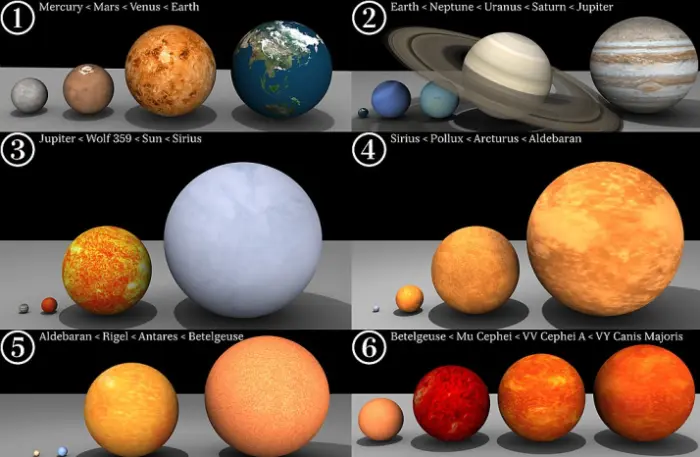
VY Canis Majoris compared to planets and other stars. Image credit: Dave Jarvis (CC BY-SA 3.0)
VY Canis Majoris compared to the Sun
With an estimated radius of about 1,420 solar radii, VY Canis Majoris has a volume almost 8 billion times bigger than that of the Sun. If placed at the centre of the solar system VY CMa would extend past the orbit of Jupiter (1,114.5 – 1,115.8 solar radii), but not quite all the way to the orbit of Saturn (1,940 – 2,169 solar radii).
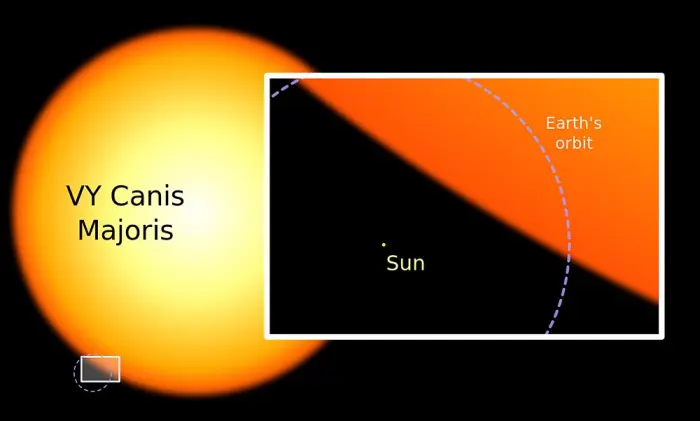
The Sun compared to VY Canis Majoris, image credit: Oona Räisänen (CC BY-SA 4.0)
VY Canis Majoris vs. UY Scuti
UY Scuti has an estimated radius of 1,708 solar radii, with a margin of error of 192 solar radii. It is most likely larger than VY Canis Majoris (1,420 ± 120 solar radii). However, as both stars are pulsating red hypergiants, their exact sizes are uncertain and some estimates of the radius of VY CMa exceed that of UY Scuti.
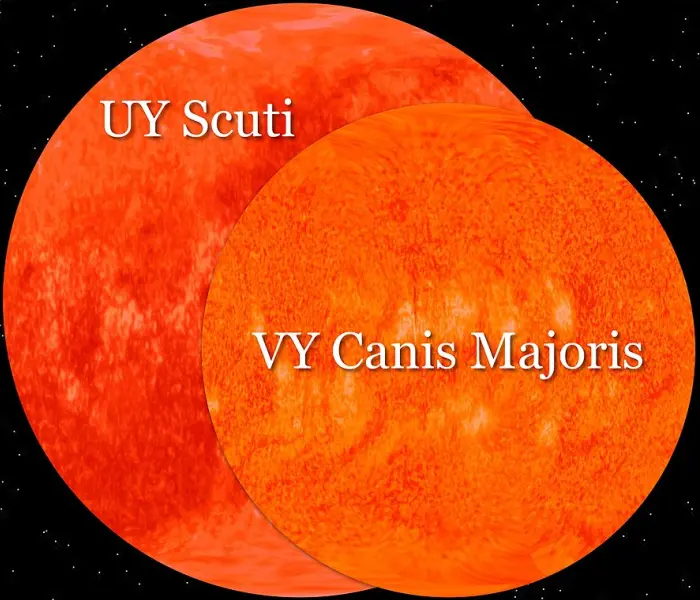
A size comparison of the red supergiants UY Scuti and VY Canis Majoris. Image credit: Wikimedia Commons/Faren29 (CC BY-SA 4.0)
VY Canis Majoris vs. Stephenson 2-18
Stephenson 2-18 (Stephenson 2 DFK 1) is currently the record-holder for the largest star known. With an estimated radius 2,150 times that of the Sun, the star would extend past the orbit of Saturn if placed at the centre of the solar system. However, the radius of Stephenson 2-18 exceeds the limits predicted by stellar evolution theory and may be unreliable.
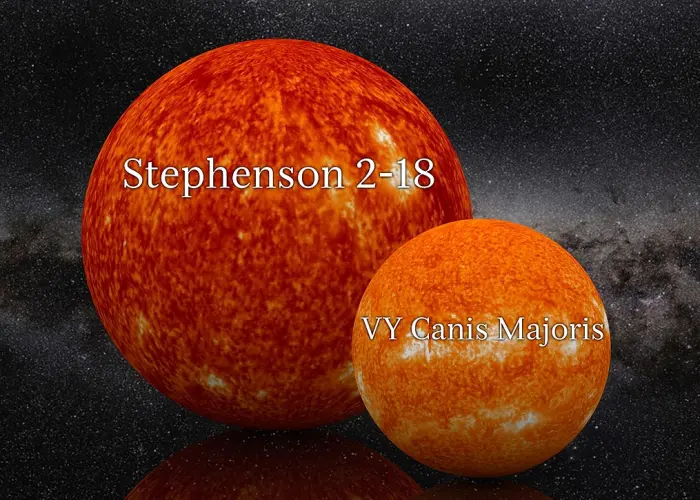
A size comparison of the red hypergiants Stephenson 2-18 and VY Canis Majoris. Image credit: Wikimedia Commons/Faren29 (CC BY-SA 4.0)
Temperature
The exact surface temperature of VY Canis Majoris is uncertain. The star’s temperature varies, causing changes in the spectrum.
The currently accepted value of 3,490 ± 90 kelvin (3,400 – 3,580 K) is based on near-infrared spectro-interferometric observations of the star with the AMBER instrument at the VLTI combined with high-precision estimates of the star’s distance.
Earlier estimates assumed a temperature below 3,000 K based on the stellar classification M5. In 2006, a study derived an effective temperature of 3,650 based on the spectral class M2.5, but the star is usually given the classification of M4 to M5, corresponding to a temperature between 3,450 and 3,535 K.
Luminosity
The luminosity of VY Canis Majoris is uncertain. Recent estimates propose a luminosity of about 270,000 or 178,000 solar luminosities. Much of the star’s light is absorbed and reprocessed by the circumstellar envelope, and most of the star’s energy output is in the infrared part of the spectrum. Without the envelope, VY CMa would be visible to the unaided eye from a distance of 3,820 light-years.
VY Canis Majoris was once thought to be more distant and estimates of its luminosity ranged from 200,000 to 560,000 times that of the Sun. One study even derived almost a million solar luminosities at a distance of 6,800 light-years. These values are close to the Humphreys-Davidson limit, the maximum luminosity of a star in hydrostatic equilibrium. Once a star exceeds this limit, it triggers a powerful, radiation-driven stellar wind from its outer layers.
Mass
VY Canis Majoris has a mass about 17 times that of the Sun, with a margin of error of about 8 solar masses. The star’s mass cannot be measured directly because VY CMa does not have any companions.
A 2012 study of the fundamental properties of VY CMa derived an initial mass of 25 M⊙ with rotation or 32 M⊙ without rotation. The values are based on observations with the AMBER instrument at the VLTI and compared to evolutionary tracks for massive stars. VY Canis Majoris has probably lost about half of its initial mass.
Like other evolved massive stars, VY CMa is a highly unstable star. It experiences enormous mass loss due to its low surface gravity and high luminosity, which cause a strong stellar wind. The star has an average mass loss rate of 6×10−4 solar masses per year, one of the highest known. During the greatest ejection events, VY CMa may have expelled more than 10-3 solar masses per year.
A study published in 2001 used infrared images and photometry and found a complex distribution of filamentary arcs and knots in the cloud of material expelled from the star. The study suggested that the arcs in the asymmetric reflection nebula surrounding the star may be the result of multiple ejection episodes attributable to localized events likely involving convection and magnetic fields on the star’s surface. Additionally, the study found that the star may have undergone high mass-loss episodes in the past millennium.
In a 2021 study led by Roberta M. Humphreys of the University of Minnesota, scientists found a record of high mass-loss episodes in the last few hundred years. They measured the radial velocities of the small knots around the star and found that VY CMa produced large mass-loss events 70, 120, 200, and 250 years ago.
Even though it is one of the biggest known stars, VY Canis Majoris is not even remotely one of the most massive ones. With a mass of about 17 solar masses, it does not even come close to the current record holders, Westerhout 49-2 (250 M☉), BAT99-98 (226 M☉), R136a1 (196 M☉), R136a3 (155 M☉) and Melnick 42 (189 M☉) in the Large Magellanic Cloud (LMC). It is also less massive than the fellow red supergiant NML Cygni (40 M☉). The mass of VY CMa is comparable to those of Betelgeuse (16.5 – 19 M☉) and Mu Cephei (19.2).
VY Canis Majoris is probably more massive than Antares (11 – 14.3 M☉) and UY Scuti (7 -10 M☉), a previous holder of the title of the largest known star.
Distance
VY Canis Majoris lies approximately 3,820 light-years from Earth. The distance is estimated based on the 2007 reduction of the data obtained with the European Space Agency’s (ESA) Hipparcos satellite, which measured the motions, positions, distances, and colours of stars from 1989 to 1993.
In 1976, C. J. Lada and M. Reid discovered a molecular cloud about 15 arcminutes east of VY CMa. They found that the cloud, catalogued as Sh2-130, had a similar velocity to the star, indicating that the two were physically associated with each other, as well as with the nearby Tau Canis Majoris Cluster (NGC 2362). The researchers suggested that VY CMa was located at a similar distance as the young cluster, about 1.5 kiloparsecs (4,830 ± 970 light-years) away. The Tau Canis Majoris Cluster is believed to ionize the rim of Sh2-310, while VY Canis Majoris is projected onto the tip of the nebula’s rim.
More recent estimates place the star about 3,900 light-yeas (1.2 kiloparsecs) away. The distance is derived based on precise parallax measurements by Choi et al. in 2008 and Zhang et al. in 2012.
In 2008, Choi et al. carried out astrometric observations of H2O masers around VY CMa using VLBI Exploration of Radio Astrometry (VERA) interferometry at the National Astronomical Observatory of Japan for 13 months. They obtained a parallax of 0.88 ± 0.08 milliarcseconds for VY CMa. This corresponds to a distance of about 3,720 light-years (1.14 kiloparsecs). This was the most accurately determined distance to the supergiant to date, as well as the first distance based on an annual parallax measurement.
In 2012, Zhang et al. used very long baseline interferometry to observe SiO (silicon oxide) masers with the Very Long Baseline Array (VLBA), a system of 10 radio telescopes in New Mexico, operated by the National Radio Astronomy Observatory (NRAO). They found a trigonometric parallax of 0.83 ± 0.08 milliarcseconds, corresponding to a distance of about 3,910 light-years (1.20 kiloparsecs). These measurements indicated that the nebula Sh2-310 was closer than previously believed and that the star was a foreground object.
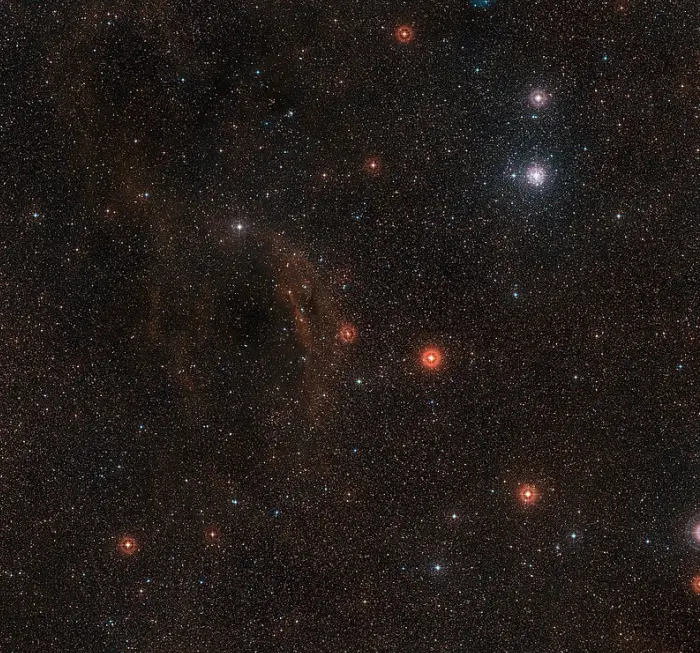
This wide-field view shows the sky around the very brilliant red hypergiant star VY Canis Majoris, one of the largest stars known in the Milky Way. The star itself appears at the centre of the picture, which also includes clouds of glowing red hydrogen gas, dust clouds and the bright star cluster around the bright star Tau Canis Majoris towards the upper right. This picture was created from images forming part of the Digitized Sky Survey 2. Image credit: ESO/Digitized Sky Survey 2; acknowledgment: Davide De Martin (CC BY 4.0)
Life cycle
Even though VY Canis Majoris is less than 10 million years old, it is a star at a late stage of its evolutionary cycle. It has burned through its supply of nuclear fuel quickly due to its high mass and evolved away from the main sequence over a million years ago. It is now fusing helium into carbon.
The hypergiant is believed to have evolved from a hot, luminous blue main sequence star of the spectral type O9, with a radius between 5 and 20 times that of the Sun. It will spend a total of 100,000 – 500,000 years in the red hypergiant phase before meeting its end as a brilliant supernova.
Observations with NASA and ESA’s Hubble Space Telescope revealed that details of the asymmetric nebula surrounding VY CMa were similar to those in the nebula around the yellow hypergiant V1302 Aquilae (IRC+10420) in the constellation Aquila. This led scientists to believe that VY CMa may be evolving blueward on the Hertzsprung-Russell diagram and will first become a yellow hypergiant, followed by a phase as a luminous blue variable (LBV), and ultimately a Wolf-Rayet star.
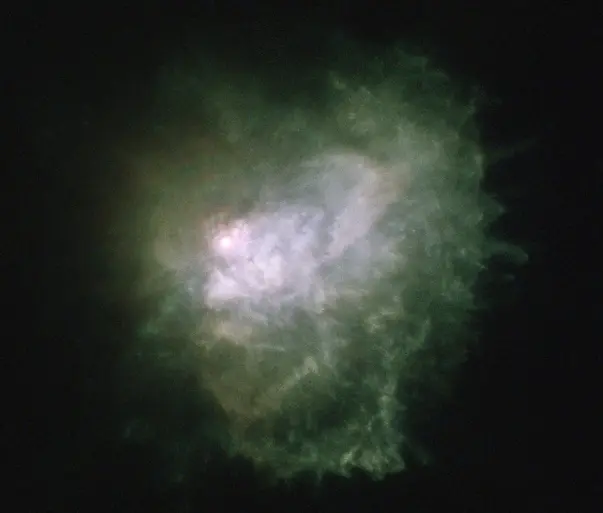
VY Canis Majoris ejecta shell, credit: Judy Schmidt (CC BY 2.0)
Supernova
VY Canis Majoris is expected to go out as a supernova within the next 100,000 years. It may produce a type IIn supernova, a superluminous supernova (SLSN), a hypernova or, less likely, a type Ib supernova. When they come to the end of their lives, big stars like VY CMa tend to leave behind a black hole rather than a neutron star.
Type IIn supernovae are relatively rare. They are typically produced by luminous blue variables. Progenitors suffer enhanced episodic mass loss shortly before they develop a nickel-iron core and collapse. The “n” suffix indicates the presence of narrow or intermediate-width hydrogen emission lines which in turn indicate the presence of a gas envelope around the star, formed of previously expelled material. The ejecta from the supernova event interacts strongly with the gas, producing the hydrogen emission lines in the spectra.
The supernova explosion may produce gamma-ray bursts (GRB). It will trigger a shock wave that will hit the circumstellar envelope at a speed of a few thousand kilometres per second and cause it to glow for a long time.
Facts
The first known observation of VY Canis Majoris was made by the French astronomer Jérôme Lalande on March 7, 1801. Lalande listed VY CMa in his star catalogue as a 7th magnitude star.
VY Canis Majoris has been known to be red since 1847. Observations made in the two centuries following the discovery showed that the star was gradually fading. By 1917, two separate observations – by Guerin and Perrine – yielded visual magnitudes of 8 to 8 ½ and, in 1935 and 1937, Florja and Robinson reported 9.3 and 8.3.
The reason for the gradual decrease in apparent magnitude could be extinction, with a denser part of the circumstellar envelope obscuring the star’s light. The drop in brightness may also be caused by a change in the emission itself.
The variability of VY CMa was first described in 1931, when German astronomer Cuno Hoffmeister listed the star as a long-period variable with a photographic magnitude varying from 9.5 to 11.5.
Between 1897 and 1970, observers reported five companions of VY CMa, all showing variations in brightness. By 1971, these were understood not to be stellar companions, but bright knots in the nebulosity surrounding VY CMa. The nebula is so bright that it was first detected in an 18-cm telescope in 1917.

If placed in the middle of our solar system, the star VY Canis Majoris would engulf all the planets out to Saturn’s orbit. This monster, appropriately called a red hypergiant, is as bright as 300,000 Suns. Yet it is so far away that, 200 years ago, it could be seen only as a faint star in the winter constellation of the Great Dog. Since then, it has faded and is no longer visible to the unaided eye. Astronomers used the NASA/ESA Hubble Space Telescope to get a close-up look at the star and discovered the reason for the dimming. The star is expelling huge clouds of dust in the final stages of its life. Eventually, the bloated star may go out as a supernova, or may simply collapse and form a black hole. This zoom into VY Canis Majoris is a combination of Hubble imaging and an artist’s impression. The left panel is a multicolor Hubble image of the huge nebula of material cast off by the hypergiant star. This nebula is approximately 300 billion kilometres across. The middle panel is a close-up Hubble view of the region around the star. This image reveals close-in knots, arcs, and filaments of material ejected from the star as it goes through its process of casting off material into space. VY Canis Majoris is not seen in this view, but the tiny red square marks the location of the hypergiant, and represents the diameter of the solar system out to the orbit of Neptune, which is 5.5 billion miles across. The final panel is an artist’s impression of the hypergiant star with vast convection cells and undergoing ejections. VY Canis Majoris is so large that if it replaced the Sun, the star would extend for hundreds of millions of miles, to between the orbits of Jupiter and Saturn. Credit: NASA, ESA, and R. Humphreys (University of Minnesota), and J. Olmsted (STScI), (CC BY 2.0)
Later observations showed that VY CMa was a single star, without any companions. American astronomer George Herbig found a total of 38 knots in the surrounding nebula using telescopes from 36 to 120 inches aperture. The knots were reported to show rapid variability, fading over a period of several months.
Herbig noted, “The image of the variable is neither stellar nor round, and attached to this elongated blob is a curved nebulous tail extending toward p.a. 290°, as well as lesser extensions in 90° and 200°.”
In 1917, Guerin observed three knots and reported that they were embedded in a small red comet-shaped nebula that had a tail extending southward. Between 1917 and 1927, the tail swung clockwise and, by 1956, it was reported to extend to the west.
VY Canis Majoris is embedded in a vast star-forming region, Sharpless 310 (Sh2-310). The molecular cloud is one of the largest H II regions in the Milky Way. It occupies 480 arcminutes of the apparent sky and has a physical diameter of 681 light years. The O-type bright giant Tau Canis Majoris and variable blue (O) supergiant UW Canis Majoris are also associated with the nebula.
VY Canis Majoris is a strong source of molecular maser emission. The star was one of the first radio masers discovered. In 1968, it was reported to be a source of radio spectral line emission from hydroxyl radicals, along with 16 other stars. The strongest radio emission line was detected from the fellow behemoth NML Cygni in the constellation Cygnus.
In 1969, VY Canis Majoris was reported to be a strong OH emission source. The source was discovered using the interferometer at the Owens Valley Radio Observatory at the California Institute of Technology in October 1968.
The star is a strong source of SiO, OH and H2O masers emission, typically found in OH/IR stars. These are red supergiants or hypergiants or stars on the asymptotic giant branch (AGB) that exhibit strong hydroxyl radical (OH) maser emission and appear exceptionally bright at near-infrared wavelengths.
Such evolved stars develop strong stellar winds and experience enormous mass loss. As the gas in the super-winds cools down away from the star, molecules like water (H2O) and silicon monoxide (SiO) are formed. As a result, grains of dust (mainly silicates) are formed that obscure the star at shorter wavelengths, leading to strong emission in the infrared. Other well-known OH/IR stars include the red supergiants/hypergiants NML Cygni, S Persei, WOH G64, V558 Normae, MY Cephei, and VX Sagittarii.
Astronomers have also detected molecules of hydrogen cyanide (HCN), sodium chloride (NaCl), phosphorus mononitride (PN), methylidyne (CH), carbon monoxide (CO), methanol (CH3OH), titanium oxide (TiO), and titanium dioxide (TiO2) in the spectrum of VY CMa.
VY Canis Majoris shows a large infrared excess and is one of the brightest sources in the sky at wavelengths between 5 and 20 microns (mid-to-long infrared). The IR excess suggests that the star is surrounded by a heated disk or dust shell.
In 2022, a team led by Ambesh Singh and Lucy Ziurys at the University of Arizona, Roberta Humphreys from the University of Minnesota and Anita Richards from the University of Manchester, created a three-dimensional image of VY CMa and traced the velocities, direction, and distribution of various molecules around the star. They used previous images of the dust, clumps, arcs and knots surrounding the star, taken with NASA’s Hubble Space Telescope, in order to map the molecules. They presented their findings at the 240th Meeting of the American Astronomical Society, held in Pasadena, California, in June 2022.
The astronomers used the Atacama Large Millimeter Array (ALMA) in the Atacama Desert of northern Chile to trace and map molecules such as sulfur oxide, sulfur dioxide, phosphorous oxide, sodium chloride, and silicon oxide. They used the data to create an image of the outflow structure of the hypergiant star.
The researchers found that the star may span anywhere from 10,000 to 15,000 astronomical units (Earth-Sun distances) and that it may be the most massive star in the Milky Way galaxy, describing it as “Betelgeuse on steroids.”
They suggested that the mass loss mechanism of VY CMa was different from those in smaller stars as they evolve into red giants in the final stages of their life cycles. In a study published in The Astronomical Journal in 2021, the team found a similarity between the outflows from VY CMa and those of Betelgeuse during the supergiant’s Great Dimming.
The team selected VY CMa because it is a rare example of a hypergiant star and it provides them with an opportunity to study what happens when these stars reach the end of their life cycles. The astronomers found that the mass loss from the star was not symmetrical, but that it entailed convection cells that expel mass through the star’s photosphere in different directions. These are similar to the coronal arcs observed in the Sun but about a billion times larger. Like the Sun’s coronal mass ejections, the gaseous outflows from VY CMa are associated with surface activity and magnetic fields. Comparable magnetic fields were detected in the ejecta of other red supergiants with maser emissions, including NML Cygni, VX Sagittarii, and S Persei.
In 2022, a study authored by Roberta M. Humphreys and Terry J. Jones presented new measurements of the ejecta from VY Canis Majoris, Betelgeuse, and other red supergiants. The researchers found that the gaseous outflows were the dominant mass loss mechanism in the most luminous red supergiants and that they contributed significantly to the mass loss in the lower-mass red supergiants like Betelgeuse.
Name
VY Canis Majoris does not have a proper name. It was given the designation VY Canis Majoris in 1939 as the 43rd variable star detected in Canis Major. Variable star designations are similar to Bayer designations, but instead of a Greek or Latin letter, they use two Latin letters or a V with a number before the Latin genitive of their host constellation.
VY Canis Majoris is catalogued as HD 58061 in the Henry Draper Catalogue, SAO 173591 in the Smithsonian Astrophysical Observatory (SAO) star catalogue, and HIP 35793 in the Hipparcos Catalogue.
Location
VY Canis Majoris is challenging to find because with an average visual magnitude of 7.95, it is invisible to the unaided eye. The star lies in the same area of the sky as the Canis Major triangle formed by Adhara, Wezen and Aludra. The three bright stars are located just south of Sirius, the brightest star in the sky. VY Canis Majoris can be found by star-hopping from Wezen, the top star of the triangle.
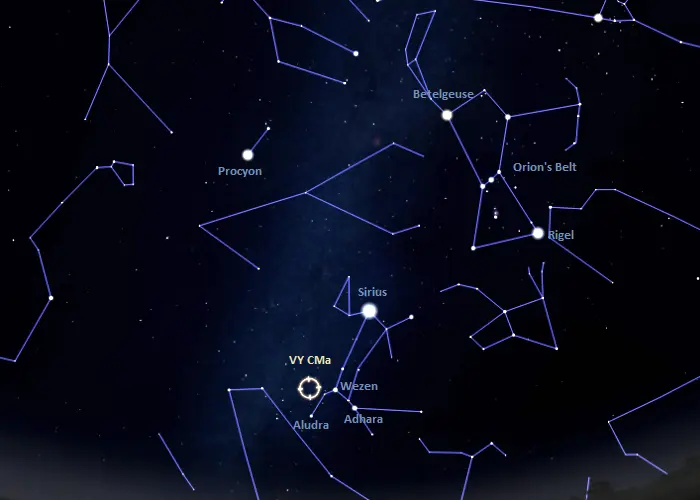
The location of VY Canis Majoris, image: Stellarium
The supergiant appears in the same area as the Tau Canis Majoris Cluster (NGC 2362), a young open cluster centred on the hot blue bright giant Tau Canis Majoris. The nebula Sh2-310 is believed to be ionized by some of the cluster’s stars.
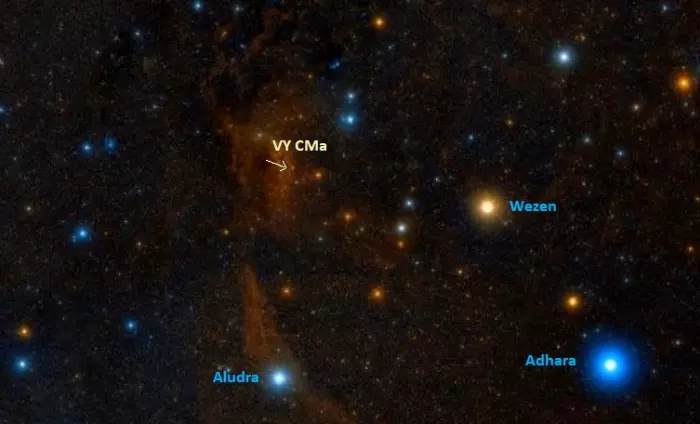
VY CMa location, image: Wikisky
Constellation
VY Canis Majoris is located in the constellation Canis Major, the Great Dog. In Greek mythology, the constellation represents the larger of the two dogs following Orion, the Hunter. (Canis Minor represents the smaller dog.) Both celestial dogs are among the 48 Greek constellations, first catalogued by the Greek astronomer Claudius Ptolemy in his Almagest in the 2nd century CE.
Canis Major is not a large constellation. It occupies an area of 380 square degrees of the southern sky and is only the 43rd constellation in size. It is nevertheless one of the best-known ones because it is home to Sirius, the brightest star in the night sky and one of the nearest stars to the solar system.
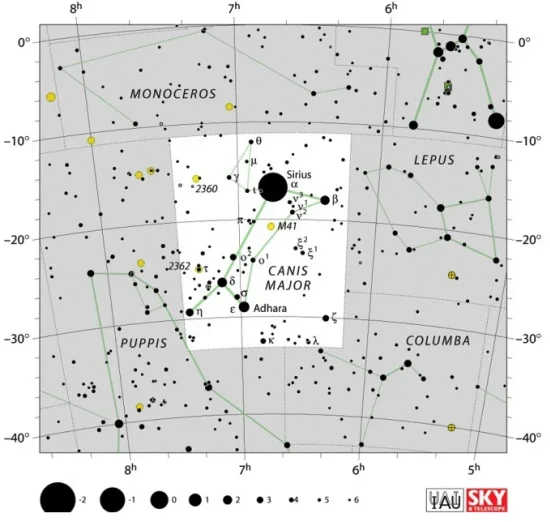
Canis Major constellation map by IAU and Sky&Telescope magazine
Canis Major contains many other notable stars, including the yellow-white supergiant Wezen, the blue supergiants Aludra and Tau Canis Majoris, and the carbon star W Canis Majoris.
Deep sky objects in the constellation include the bright open clusters Messier 41, the Tau Canis Majoris Cluster (NGC 2362), and Caroline’s Cluster (NGC 2360), the emission nebula NGC 2359 (Thor’s Helmet), the merging galaxies NGC 2207 and IC 2163, and the Canis Major Dwarf, the nearest neighbouring galaxy to Earth.
The best time of the year to observe the stars and deep sky objects in Canis Major is during the month of February, when the constellation is prominent in the evening sky. The entire constellation is visible from locations between the latitudes 60° N and 90° S.
The 10 brightest stars in Canis Major are Sirius (Alpha CMa, mag. -1.46), Adhara (Epsilon CMa, mag. 1.50), Wezen (Delta CMa, mag. 1.824), Mirzam (Beta CMa, mag. 1.985), Aludra (Eta CMa, mag. 2.45), Furud (Zeta CMa, mag. 3.025), Omicron2 Canis Majoris (mag. 3.043), Unurgunite (Sigma CMa, mag. 3.43 – 3.51), Kappa Canis Majoris (mag. 3.40 – 3.97), and Omicron1 Canis Majoris (mag. 3.78 – 3.99).
VY Canis Majoris
| Spectral class | M3–M4.5 (M2.5 – M5e Ia) |
| Variable type | Semiregular variable (SRc) or slow irregular variable (Lc) |
| U-B colour index | +2.32 |
| B-V colour index | +2.057 |
| V-R colour index | +2.20 |
| Apparent magnitude (V) | 6.5 – 9.6 |
| Apparent magnitude (V) | 7.95 |
| Apparent magnitude (U) | 12.01 |
| Apparent magnitude (B) | 10.19 |
| Apparent magnitude (J) | 1.98 |
| Apparent magnitude (H) | 0.44 |
| Apparent magnitude (K) | -0.72 |
| Distance | ~3,820 light years (3,590 – 4,080 ly) or 1,170 parsecs (1,100 – 1,250 pc) |
| Parallax | 0.83 ± 0.08 mas |
| Radial velocity | 56.13 ± 0.68 km/s |
| Proper motion | RA: -2.645 ± 0.309 mas/yr |
| Dec.: 2.232 ± 0.405 mas/yr | |
| Mass | 17 ± 8 M☉ |
| Luminosity | 270,000 ± 40,000 L☉ or 178,000 (148,100 – 218,900) L☉ |
| Radius | 1,420 ± 120 R☉, 2,069 R☉ |
| Temperature | 3,490 ± 90 K |
| Metallicity | -0.3 dex |
| Age | 8.2 million years |
| Rotational velocity | 300 km/s |
| Surface gravity | −0.6 ± 0.4 cgs |
| Constellation | Canis Major |
| Right ascension | 07h 22m 58.3261352189s |
| Declination | −25° 46′ 03.194390594″ |
| Names and designations | VY Canis Majoris, VY CMa, HD 58061, HIP 35793, SAO 173591, PPM 252258, CD-25 4441, CPD-25 2286, GSC 06541-02525, RAFGL 1111, IRC -30087, GCRV 27408, GCRV 27369, GCRV 4908, UCAC4 322-023976, WEB 7134, OH 239.3 -5.1, TIC 107149174, WISE J072258.10-254603.5, IRAS 07209-2540, 2MASS J07225830-2546030, AAVSO 0718-25, ADS 6033 AB, WDS J07230-2546AB |